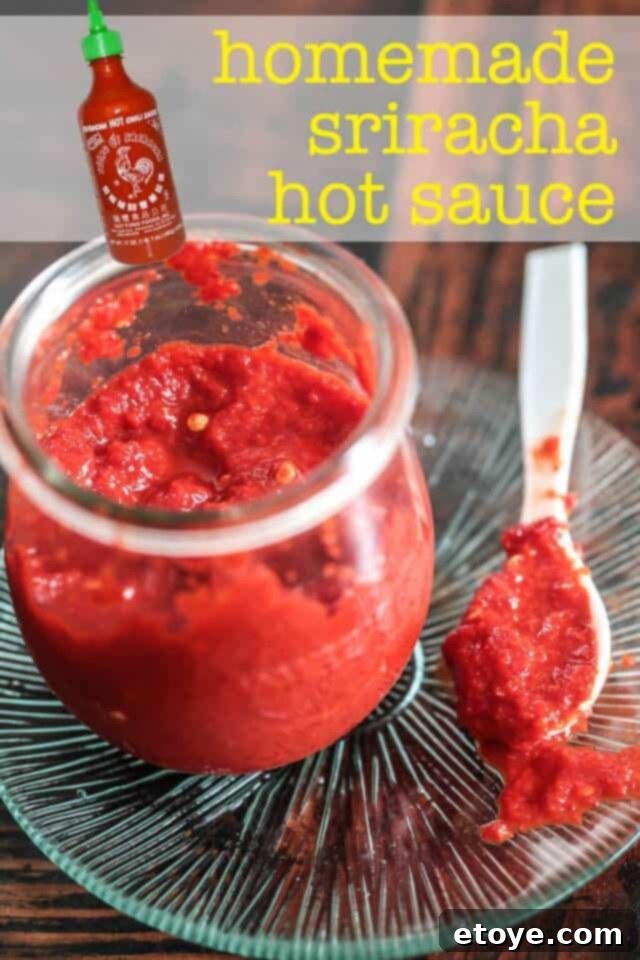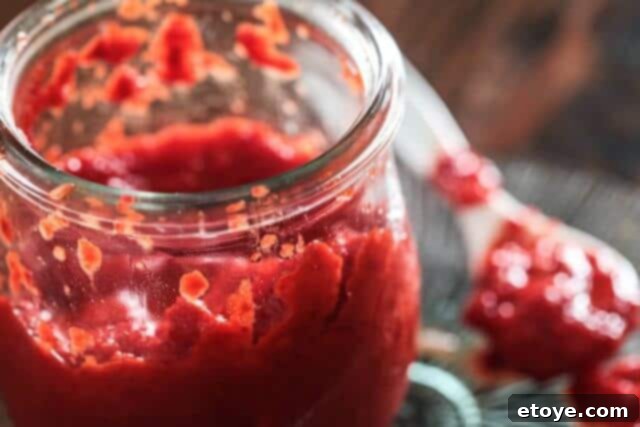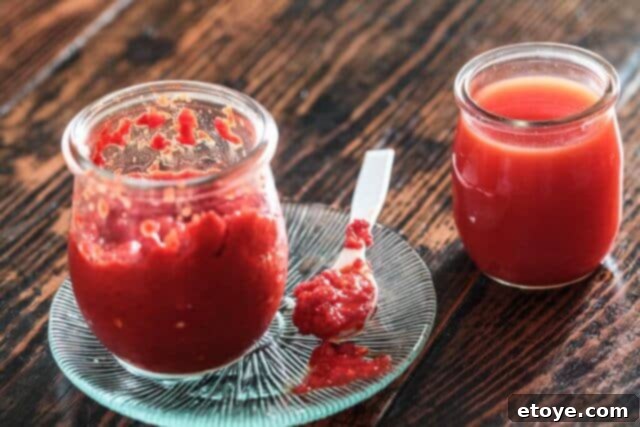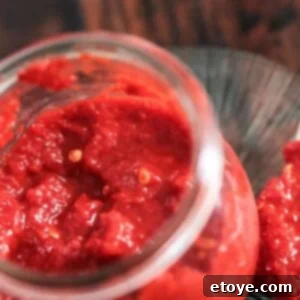Welcome to the ultimate guide for crafting your very own homemade Sriracha Hot Sauce, a recipe so remarkably close to the beloved Huy Fong original, you’ll wonder why you ever bought it from a bottle. The secret to its authentic, complex flavor and vibrant kick lies in a simple yet transformative process: fermentation. This method, inspired by Karen Solomon’s acclaimed “ASIAN PICKLES” cookbook, elevates mere ingredients into a condiment brimming with depth and character, offering a truly unparalleled culinary experience right from your kitchen.

Unlocking the Magic of Fermented Sriracha: Why This Recipe Is a Game-Changer
Diving into the world of homemade condiments can be incredibly rewarding, and this fermented Sriracha recipe is a prime example. It’s not just about replicating a favorite sauce; it’s about understanding and controlling the flavors to create something truly special. For those who adore the iconic red rooster sauce, this recipe offers a path to a fresher, more personalized version with an incredibly similar profile.
- A Near-Perfect Replication: If you’re a devoted fan of the store-bought Huy Fong Sriracha, prepare to be amazed. This recipe consistently yields a sauce that captures the signature balance of heat, sweetness, tang, and umami that defines the original. The fermentation process is key to developing this authentic flavor, setting it apart from quick-blend recipes.
- Exceptional Longevity: Thanks to the natural preservation power of fermentation and the addition of vinegar, your homemade Sriracha will remain fresh and flavorful for months when stored in the refrigerator. This allows you to enjoy your efforts over a long period, making it a staple in your culinary arsenal.
- Unbelievably Versatile: Once you have a batch of this vibrant sauce, you’ll find countless ways to incorporate it into your meals. From breakfast staples like scrambled eggs and avocado toast to savory dinners like Pho, burgers, tacos, and grilled vegetables, Sriracha adds an irresistible spicy kick and a burst of flavor that enhances almost any dish. It’s the ultimate condiment for elevating everyday meals.
- A Symphony of Flavors: This Sriracha boasts a perfect equilibrium of tastes. It’s sweet enough to be palatable, sour enough to tantalize the taste buds, salty enough to enhance other flavors, and savory enough to leave you craving more. This harmonious blend is what makes it so addictive and versatile.
The Essential Ingredients for Your Signature Sriracha
Creating an exceptional Sriracha begins with selecting high-quality, fresh ingredients. Each component plays a vital role in achieving that distinct, balanced flavor profile.
- Fresno Chiles: These bright red peppers are the foundation of our Sriracha. They offer a medium heat level, similar to red jalapeños, and a slightly fruity, smoky flavor that contributes significantly to the sauce’s character. Their vibrant red hue is also crucial for the iconic color.
- Garlic Cloves: Fresh garlic is indispensable, providing a pungent, aromatic depth that balances the heat of the chiles and adds complexity to the fermented flavors.
- Kosher Salt: More than just a seasoning, kosher salt is critical for the fermentation process. It creates an environment where beneficial bacteria thrive, breaking down the chiles and developing nuanced flavors while inhibiting undesirable mold growth.
- White Vinegar: Added at the end of the fermentation process, distilled white vinegar provides the necessary tang, brightens the overall flavor, and acts as an additional preservative, ensuring your sauce stays fresh longer.
Crafting Your Aged Sriracha Hot Sauce: A Detailed Step-by-Step Guide
The journey to your perfect homemade Sriracha is a straightforward one, culminating in a sauce that bursts with flavor. Follow these detailed steps to ensure success.
- Begin by thoroughly washing your Fresno chiles under cool running water. Carefully chop off their stems. If you prefer a milder sauce, now is the time to remove the seeds and the white membranes from inside the chiles, as these contain most of the capsaicin, which is responsible for the heat. Discard them if removed.
- To ensure your food processor isn’t overloaded and to achieve a consistent puree, process the ingredients in two batches if necessary. Add the prepared chiles, peeled garlic cloves, and kosher salt to your food processor. Pulse and then process continuously for about 2 minutes. The goal is to achieve a very liquid mixture, resembling the consistency of a thick smoothie, with a slightly foamy layer on top. This fine puree is essential for proper fermentation and a smooth final sauce.
- Carefully scrape the chile mixture into a very clean 1-quart (or larger) glass jar. Glass is crucial for fermentation; avoid using plastic, as it can harbor bacteria and interact with the fermenting ingredients. Cover the opening of the jar with a piece of paper towel or a clean coffee filter, and secure it tightly with a rubber band. This allows the sauce to breathe, releasing gases produced during fermentation, while preventing airborne contaminants or insects from entering.
- Place the covered jar in a cool, dark place, away from direct sunlight and extreme temperature fluctuations, for 2 to 4 days. During this period, the magic of fermentation begins. You’ll observe the liquid separating and settling at the bottom, while a thicker paste-like sauce rises to the top. The most exciting sign of active fermentation will be small bubbles appearing on the surface of the sauce, indicating that beneficial microorganisms are at work. While 2-4 days is a good starting point, feel free to taste the sauce after this period. If you desire a deeper, more complex fermented flavor, allow it to sit for a few more days. Many enthusiasts, including myself, find that 7 days of fermentation yields the most desirable results.
- After fermentation, pour the entire contents of the jar through a fine-mesh sieve set over a bowl. Allow the thinner, vinegary liquid to drip through, which will resemble a Tabasco-style hot sauce. The thicker, pulpy chile paste will remain in the sieve. You will now have two distinct sauces. To each, add 3 tablespoons of distilled white vinegar and stir thoroughly. This final addition of vinegar balances the flavors and boosts preservation.
- For those who prefer a finer, smoother consistency reminiscent of store-bought Sriracha, take the thicker chile paste and run it through a blender one more time. This step is entirely optional but highly recommended if you desire a less chunky sauce.
- Store both the thicker Sriracha-like sauce and the thinner vinegar hot sauce in separate, tightly sealed glass containers in the refrigerator. The thicker fermented Sriracha will maintain its quality and flavor for up to 4 months. The thinner vinegar hot sauce, due to its higher acidity, will keep indefinitely, providing a versatile spicy condiment for various uses.
A Deep Dive into Aged Sriracha Hot Sauce: The Fermentation Advantage
While I’ve experimented with numerous hot sauce recipes over the years, this particular Aged Sriracha Hot Sauce recipe stands out as the closest homemade rendition to the iconic store-bought version I have ever encountered. The fundamental secret to its success, as I discovered, lies in a simple yet incredibly powerful technique: fermentation. This revelation came from Karen Solomon’s superb cookbook, “Asian Pickles: Sweet, Sour, Salty, Cured, and Fermented Preserves from Japan, Korea, China, India, and Beyond.”
This cookbook is an absolute treasure for anyone fascinated by the art of preserving and flavoring, offering a comprehensive tribute to the diverse world of sweet, sour, salty, cured, and fermented delights from across Asia. I wholeheartedly recommend “Asian Pickles.” Karen’s recipes are not only simple to follow but her instructions are remarkably clear and concise, making complex techniques accessible to home cooks. If you possess a love for tangy, spicy condiments and an adventurous palate, “Asian Pickles” will undoubtedly resonate with you, opening up a world of flavor possibilities.
My journey into fermented hot sauce began by following her “Fermented Cock Sauce” recipe from the book, and the results were nothing short of spectacular. Prior to this, I had never attempted to ferment hot sauce, but to my pleasant surprise, the process proved incredibly easy. It essentially involved mixing the ingredients, placing them in a clean jar, and then simply leaving the jar undisturbed in a cool, dark cupboard for about a week. In fact, it was so effortless that I almost forgot about it entirely until the fermentation was complete, signaling a minimal-effort, maximum-reward endeavor!

Achieving Your Desired Sriracha Consistency: Thick, Smooth, or Both?
One of the beauties of making Sriracha at home is the ability to customize its texture to your exact preference. My personal rendition of this homemade Sriracha is notably thicker and often chunkier than the ultra-smooth Huy Fong Sriracha, and this was an intentional choice. The recipe’s final straining step is crucial here. When you strain the fermented puree, you separate the thinner, vinegar-like hot sauce (which strikingly resembles Tabasco) from the more substantial chile paste. The amount of pressure you apply during this straining process directly influences the final texture of your Sriracha-like sauce.
In the accompanying video, you might observe me pressing down quite forcefully on the chile paste in the sieve to extract as much of the liquid as possible. This vigorous straining resulted in a denser, chunkier sauce. If you prefer a Sriracha with a smoother, less chunky consistency, similar to the bottled version, I recommend a lighter straining. Alternatively, after the initial straining and vinegar addition, you can always run the thicker sauce through a high-speed blender one more time. This extra blend will break down any remaining solids, yielding a wonderfully smooth, pourable sauce that glides effortlessly over your food.
Beyond texture, the resulting flavor profile of this homemade version is distinctively brighter, fresher, and possesses a more pronounced “fruity” character compared to its bottled counterpart. This vibrancy is a hallmark of fresh ingredients and successful fermentation. While I haven’t extensively experimented with longer fermentation periods myself, it’s an interesting thought to consider whether extending the fermentation time could contribute to a deeper, more earthy flavor profile, potentially bringing it even closer to the aged notes often found in commercially produced Sriracha.

Selecting Your Signature Peppers: The Heartbeat of Your Hot Sauce
The choice of peppers is paramount to defining the heat, flavor, and color of your homemade Sriracha. While the original Huy Fong Sriracha famously uses red jalapeño peppers, sourcing these can sometimes be a challenge. The great news is you have flexibility!
You can truly use any red peppers you prefer for this recipe. My recommendation, and what Huy Fong traditionally uses, are red jalapeño peppers. Yes, red jalapeños do exist! They are simply mature green jalapeños that have been left on the plant to ripen, developing a sweeter flavor and often a slightly higher heat level than their green counterparts. However, they can be elusive in standard grocery stores.
Karen Solomon, in her “Asian Pickles” cookbook, wisely suggests using Red Fresno peppers as an excellent alternative. Fresno peppers possess a similar taste and heat index to red jalapeños, making them a fantastic substitute that’s often easier to find. I’ve had success locating red jalapeños at larger supermarkets like Super Target and Publix, but don’t hesitate to ask your local produce manager to stock them for you; many stores are happy to accommodate requests.
A golden rule for Sriracha: red peppers equal red sauce! To maintain the visually appealing, vibrant red color of traditional Sriracha, it’s essential to use red-hued peppers. If you’re like me and enjoy a hot chile sauce that offers flavor without an overwhelming burn, consider incorporating baby red bell peppers into your blend. Adding a few red bell peppers can effectively mellow the heat of the spicier chiles, contributing a touch more sweetness and a milder overall taste without compromising the beautiful red color.
One of the fantastic aspects of the recipe adapted from “Asian Pickles” is that it’s essentially a two-for-one deal! After the fermentation and straining process, you’ll be left with two distinct, delicious products: the thicker, rich, Sriracha-like sauce on one side, and a thinner, bright, vinegary hot sauce reminiscent of Tabasco on the other. This duality offers versatility and ensures no part of your fermented chiles goes to waste!

Top Tips for Sriracha Success: Mastering Your Homemade Hot Sauce
To ensure your homemade Sriracha turns out perfectly every time, keep these expert tips in mind:
- Customize the Heat: The spiciness of your Sriracha is entirely within your control. Experiment with different types of red chilies to achieve your preferred heat level. For a milder sauce, remove more seeds and membranes from the chiles. For an extra kick, leave them in! Remember, using only red chilies is key to maintaining that signature red color.
- Control the Consistency: If you desire a thinner, smoother sauce that closely mimics the texture of Huy Fong Sriracha, be gentle during the straining process. Avoid pressing too hard on the chile paste in the sieve. As you’ll see in the video, a forceful press results in a chunkier sauce. A light strain allows more liquid to remain with the solids, yielding a less dense final product.
- Blend for Ultimate Smoothness: Should your sauce still be too chunky for your liking after straining and the initial blend, don’t hesitate to run it through a high-speed blender one more time before bottling. This will further emulsify the sauce, creating an exceptionally smooth and uniform consistency.
- Embrace the Longevity: One of the most significant advantages of fermentation is extended shelf life. Both the thicker Sriracha-style sauce and the thinner vinegar hot sauce will keep beautifully for months in the refrigerator when stored in airtight containers. This allows you to enjoy the fruits of your labor for a long time.
Watch the Process: How to Make Sriracha Sauce Video
For a visual guide to each step, from preparing your chilies to the final bottling, watch this helpful video:
Explore More Saucy Creations
If you’ve enjoyed crafting this flavorful Sriracha, you’re likely a fan of bold, saucy dishes. Be sure to check out these other tantalizing recipes that feature incredible sauces:
- Shrimp Wonton Recipe in a Spicy Sichuan Sauce
- Malaysian Chicken Noodle Soup with Asian Greens and Chili-Soy Sauce
- Scallops with Apricot Sauce
- Salmon with Magical Butter Sauce
Have you embarked on the exciting journey of making this Aged Sriracha Hot Sauce recipe? We’d love to hear about your experience! Feel free to leave a star rating and share your thoughts, tips, and any delicious uses for your homemade Sriracha in the comments section below!

Aged Sriracha Hot Sauce Recipe
Pin Recipe
Ingredients
- 2 pounds Fresno chiles or other red chilies
- 9 cloves garlic
- 2 teaspoons kosher salt or 1 tsp regular table salt
- 6 tablespoons distilled white vinegar
Instructions
- Wash the chiles and chop off their stems. If you like your sauce less hot, remove the seeds and membranes and discard.
- Work the next step in 2 batches so you don’t overload the food processor.
- Add the chiles, garlic, salt to the food processor. Process for 2 minutes until very liquid. The mixture should have consistency of a smoothie and appear a bit foamy on top.
- Scrape the sauce into a very clean 1-quart (or larger) glass jar. Don’t use plastic. Cover the top of jar with paper towel and secure with rubber band. This prevents bugs from entering and allows sauce to breathe.
- Place jar in cool, dark place for 2-4 days. The liquid will settle at bottom, and the thicker sauce will rise to top. The top should be bubbly – which is a sign of fermentation. Taste, and let sit for a few more days if desired. I prefer 7 days of fermentation.
- Pour the sauce through a fine-mesh sieve. Now you’ll have the thinner “Tabasco” like vinegary hot sauce and the thicker hot chile sauce. To each, add 3 tablespoons of vinegar and stir well.
- You may like to run the thicker sauce through the blender for a finer, thinner consistency.
- Store each tightly sealed in refrigerator. The thicker hot sriracha sauce will keep for up to 4 months. The thinner vinegar hot sauce will keep indefinitely.
